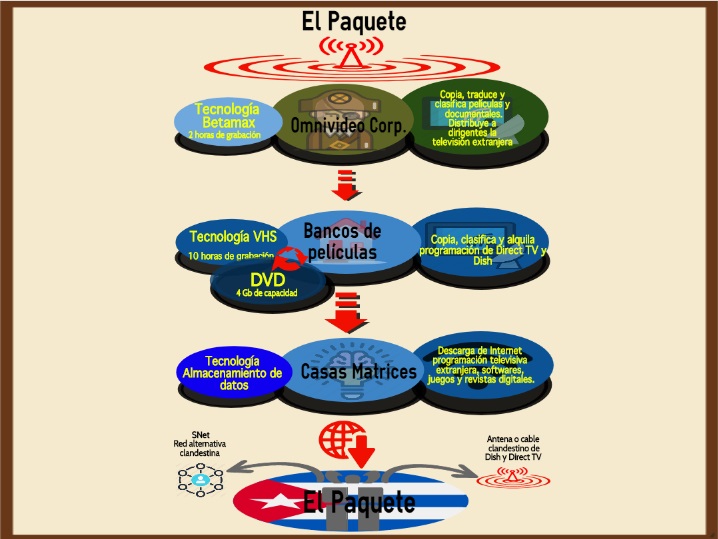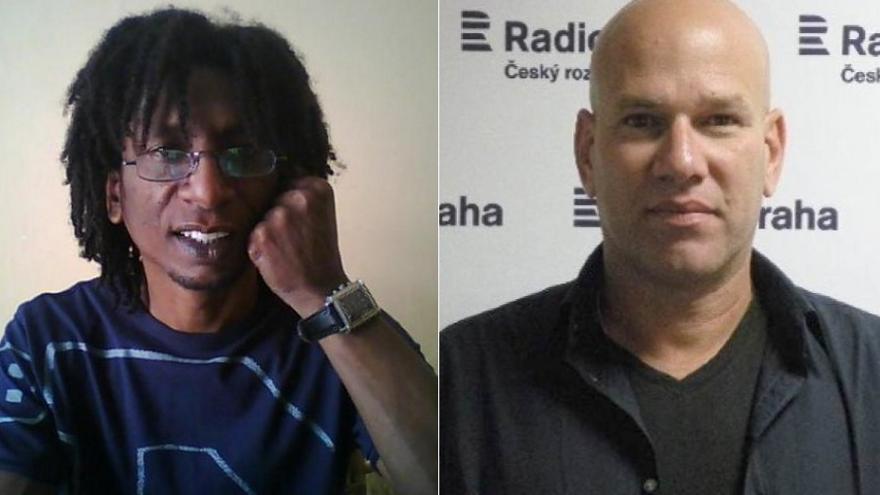The current digital collection of a terabyte of foreign TV content, software and digital magazines, began to displace Cuban TV when Betamax technology, which entered the market in 1975, arrived in Cuba.
Betamax became popular in Cuba shortly before disappearing, with a format that allowed 2 hours of recording. During its first years of its introduction in the country, few Cubans, outside the ruling elite, owned this home technology, which initiated the alternative circulation of films and documentaries in the U-matic format.
It was through the governmental company, Omnivideo Corporation, located in the residential area of Siboney in Havana’s Playa municipality, that people began to copy, translate, classify, distribute on the island and sell abroad, movies that had been shown in the U.S.
A participant in the corporation, a former Interior Ministry official who offered statements on condition of anonymity, said that Omnivideo Corp. did more than pirate movies.
“The company was created by Tony de la Guardia and then absorbed by CIMEX to sell films in Cuba. Omnivideo not only sold movies, it also distributed to the country’s leaders, through cables, the channels that were captured with a group of antennas that were located in Siboney.”
The same source adds that, by means of a Panamanian citizen linked to the premiere theater circuit in Panama City, the films remained in Cuban hands for less than 24 hours.
“That Panamanian took the premiere tapes to the Cuban embassy, they sent them from there to Cuba, they copied them, and the same day they sent them back to Panama.”
Deep in the enjoyment of capitalism, the socialist leadership did not notice that the era of domestic technology had begun in Cuba. Their piracy formulas would soon be copied by others.
The films of Chuck Norris and Sylvester Stallone confronting Vietnamese communism invaded the island. Cubans eager to discover everything distant from Russian culture, embedded in the small screen, created small movie theaters around a Betamax to watch the films pirated by Omnivideo Corp. The point of no return of the pirating of foreign images between Cubans had started.
A great number of films not associated with the official piracy began to be added to the nascent popular video cassette exchange. The documentary “Nadie Escuchaba” (Nobody Listened) by Néstor Almendros (1987) was one of the films that had the privilege to come the black and white screens, which still coexisted with the Betamax in Cuban homes.
To compete with the avalanche of Hollywood programming, Cuban television introduced the “Saturday Movie” program, a “healthy” version of American cinema that ended up displacing Russian cinematography from the official collection.
VHS and DVD, the adolescence of the Packet
At the beginning of the 90s, the VHS format arrived in Cuba, which had been on the market elsewhere since 1976. The recording capacity of that stimulated the creation of movie rental banks.
VHS with a capacity of up to 10 hours, in LP mode (Long play), facilitated the compendium of foreign programs that the Cubans took advantage of to create clandestine independent businesses in the style of Omnivideo Corp. In Cuba the EP (Extended play) format was used in NTSC (30 frames per second), the lower image quality.
The illegal Direct TV and Dish antennas were the alternatives that Cubans found to copy foreign programming. Popular among wealthy citizens, the so-called “Caciques” (chiefs) for years dominated the recording of programs, novels and movies that the film banks bought for a price, which according to how current or recently released they were.
Rogelio Reyes started his film bank that included the Betamax format. In an interview with CubaNet, he narrated his compendium experiences in the different formats, Beta, VHS, DVD.
“Beta lasted just a short time, although I remember that shows were already being recorded (…). In VHS I came to have almost five thousand cassettes, among them soap operas, films and documentaries.”
Rogelio remembers that the Caciques sold the compendium (VHS) for between 50 and 60 pesos. Once acquired, a classification process was carried out, perfected in the current Packet.
“In the bank I recorded in EP format to allow more hours of programming. Sometimes there were varied Packet of shows with soap operas, that was according to what you saw what the clients wanted (…). VHS was outdated the fastest, it did not last two years. Right after DVDs arrived (…) I had to give away all the VHS cassettes.”
The adolescence of the Packet was gaining strength with the format war. In the libraries of the film banks, the DVD with more content and better visual quality was imposed. The extinction of the VHS was extended due to the high cost of the first DVD players, that oscillated between 200 and 250 dollars, in the black market.
While the population updated with the new format, data storage devices appeared, popularized in Cuba during their second generation, launched at the beginning of this century.
Data storage, the maturity of the Packet
The ability to have greater storage capacity and the recopying of the content in the data devices (USB, hard drives), revolutionized alternative programming on the island. Until then the DVD, up to 4 GB, offered limited capacity without the ability to recopy.
The determining factor for the increase of those involved in the business was the arrival of computers, and with them, the television signal capture cards.
Mario Cabrera, who was part of this evolution, explained to CubaNet his participation in the chain of program copiers.
“I had antenna service of one channel. Since I had a TV capture card, I was hired by one of those who copied for the Packet (…) He suggested that I record two shows: Sábado Gigante and Belleza Latina. I remember that, when the program was over, a person would come by and pick up what I had recorded, and he would pay me 5 convertible pesos (CUC) for each program.”
This group paid tribute to a new formula that annihilated the hegemony of the Caciques: the head offices. They began to use computers, hard drives and finally the internet to download and organize the materials contained in the Packet.
Reloj Club (Club Clock) was one of the first head offices that identified the users, created by two young people known as Robert and Mayito.
Alexis Rodríguez Tamayo (known as el Nene), a graduate of the University of Computer Sciences (UCI), inherited Club Reloj when its founders left the country. The engineer who is currently the owner of the Omega house, told CubaNet about his experiences at the beginning of the current Packet.
“The Packet came from the movie banks. The computers opened the door, and the younger ones skillfully saw the way to supply the banks. It was not anyone in particular who created the Packet.”
Alexis Rodríguez recalls that among the best-known head offices were “Paquete de Lachy,” “Samuel” and “Joe PC,” who, in his opinion, “stole all the customers.”
“That boy revolutionized everything, when the novelas were not sold by episodes, he started selling them by episodes. We all had to sell them by episodes or we lost our customers. (…) After that, it shortened the frequency of the weekly collection, to a daily delivery. There are distributors or head offices that do not wait for the end of the week, they buy the programming that is downloaded daily, to be more current.”
Alexis does not believe that technological advances can eliminate the Packet. About this, he said: “Now with the Internet, I think that when another six months pass, the clientele will weaken. But there are many who will pay for the information because they do not have internet at home, or do not have the time [i.e. cannot afford to pay for it] to download. (…) We download the movies as soon as they come out, the series are downloaded, the games are such large files that we download them in snippets, and if it’s not today, it’s tomorrow.”

The Packet within the antenna or cable
Then, without the need to store the content, the Packet’s programming was inserted in SNet, an illegal wireless community. What nobody imagined is that this programming would return to the users through its origin: the clandestine service of the antenna.
The antenna or cable that began offering one channel for 10 CUC, now, for the same price, includes thirty-two channels in some areas of the capital city. This variety of channels makes Dish and Direct TV share their popularity in Cuba with channels designed by Cubans with the contents of the Packet. Through the WD Elements Play technology (multimedia hard drive), 2 Tb of programming are broadcast through the illegal antenna.
El Paketito (the Little Packet)
Since the beginning of the current Packet, the authorities of the Island have confronted it with a variety strategies. More variations of official television, creation of the Mochila (“Backpack” — the official packet), police operations and, according to the testimony of officers of the political police, the creation of a group named “Paqueteria,” specialized in spying on the whole chain of creation and distribution.
The country’s vice-president, Miguel Diaz-Canel, publicly expressed his concern: “We aren’t bothered by the Packet as an idea, but with the values, the culture and the ways in which it can be transmitted,” he said. Other government figures attack it as a degrading ideological and aesthetic concept.
To protect themselves, those who make the Packet make the decision to self-censor. They eliminate from the content any information — be it in soap operas, news or websites — that affect the image of the government.
The fill this gap El Paketito (The Little Packet) arose. A compendium of information that adds what is censored to the Packet.
Its creator broke, for the first time, its main rule: Do not offer an interview to the media. Under the condition of protecting his identity for fear of reprisals, he told CubaNet:
“The first thing is that, due to the censorship, the difficulties of accessing the Internet, the publications of independent media are greater abroad. The idea of the Paketito is to take all that censored information to its first consumer, the ordinary Cuban.”
Based on the idea of the Packet, the Paketito was created in February 2015 with a weekly frequency. Its content includes all the information from the platforms used by the independent press, television news programs, documentaries of political content, and animated series censored by the Packet, with radio programs and Cuban image archives.
“It has had good acceptance throughout the country, because it divulges the forbidden,” said its creator, adding. “Cubans want to know what happens on the other side of censorship and we respect that.”

![]() 14ymedio, Havana, 21 May 2018 — The Pro Free Press Association (APLP) condemned, on Sunday, the arrest of two independent journalists when they tried to cover the crash of the Boeing 737 leased by the Cuban airline Cubana de Aviacion, which killed 110 people.
14ymedio, Havana, 21 May 2018 — The Pro Free Press Association (APLP) condemned, on Sunday, the arrest of two independent journalists when they tried to cover the crash of the Boeing 737 leased by the Cuban airline Cubana de Aviacion, which killed 110 people.

